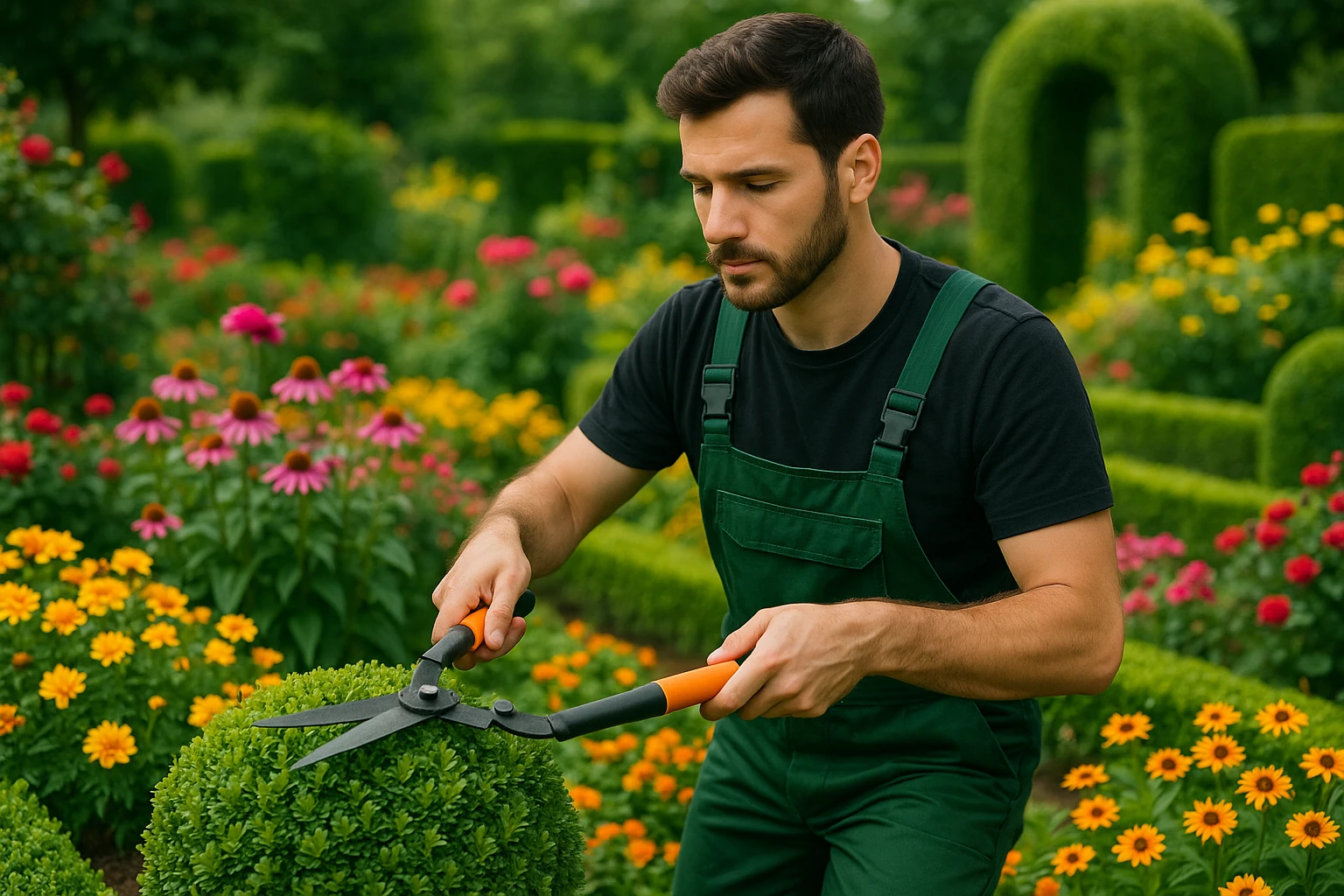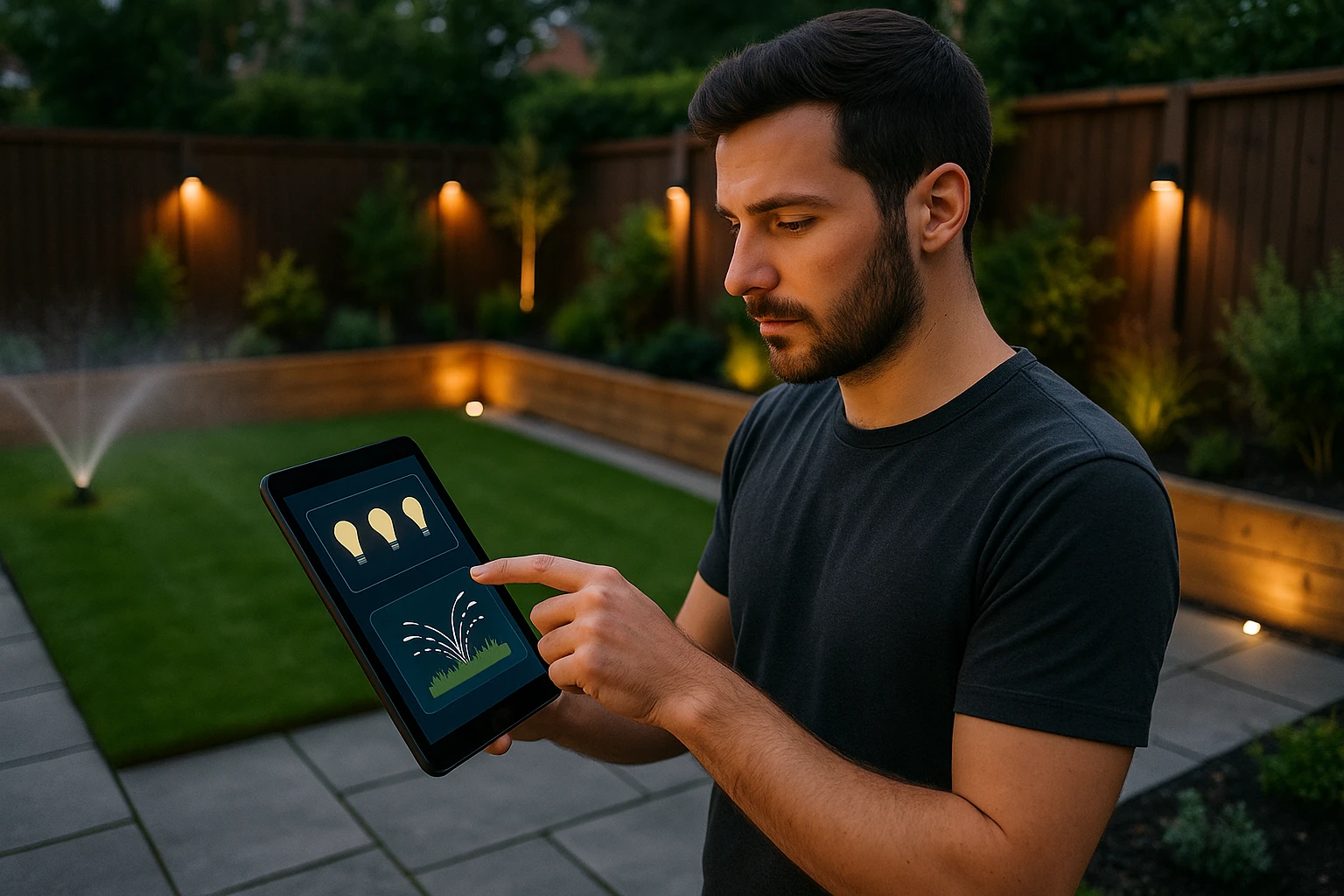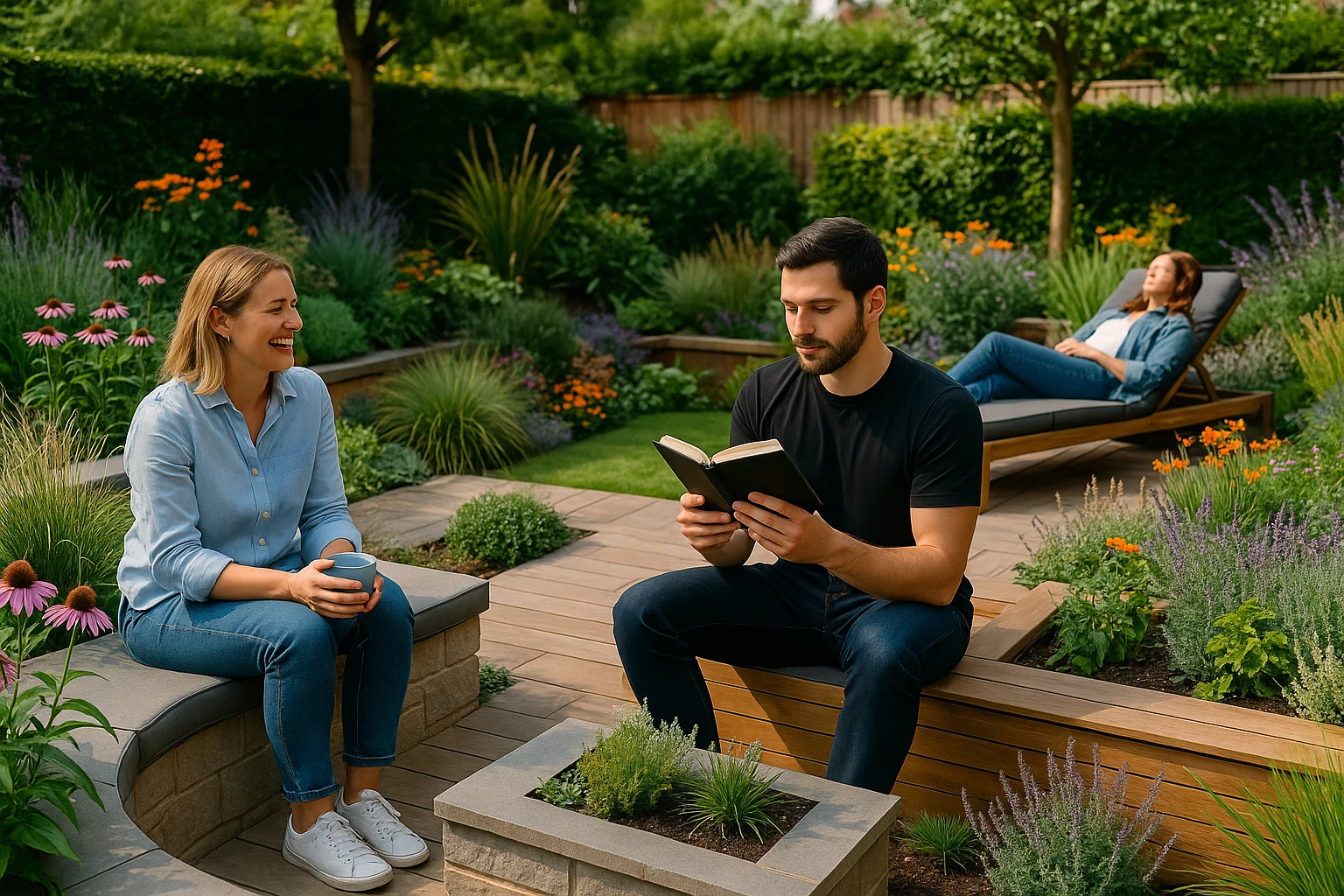Blog sidebar
Category
Recent Posts
- Dec 07, 2025
- Dec 05, 2025
- Dec 05, 2025
- Dec 02, 2025
- Dec 01, 2025
- Dec 01, 2025

Transform Your Space: The Comprehensive Guide to Home and Garden in the UK
Contents
Introduction
Imagine stepping into your own slice of paradise every morning—a place where fresh mint for your tea grows beside vibrant roses, and a quiet seating nook offers respite after a busy day. Such is the allure of creating a thoughtfully designed home and garden UK space: more than aesthetics, it’s about enhancing wellbeing, boosting property value, and embracing sustainability.
In the UK, the environmental horticulture sector makes a robust contribution to the national economy. In 2023 alone, it added approximately £38 billion to the UK’s GDP, with projections indicating growth to over £51 billion by 2030 [Hillarys Garden Industry Statistics 2025]. That figure underscores the scale and economic weight of home gardening and landscaping in Britain.
On the ground, gardening is a truly national pastime. Around 43 million UK adults—equivalent to about 78 percent of the population—have access to private garden space, and roughly 27 million people actively engage in gardening as a hobby [Hillarys Garden Industry Statistics 2025]. The average garden spans approximately 14 m², offering a compact, yet meaningful outdoor canvas for creativity and relaxation.
These statistics reveal a compelling opportunity: whether you’re looking to cultivate calm and wellness, grow your own produce, or increase your home’s appeal, focusing on the home and garden UK market taps into widespread enthusiasm and solid economic momentum. In the coming sections, we’ll delve into design trends, sustainable practices, and actionable strategies to make the most of your garden space in every season.
This opening sets the stage for a detailed exploration into how to transform your outdoor area, whether modest or expansive, into a purposeful extension of your home—melding beauty, functionality, and value in one cohesive space.
2. Understanding the Landscape: Scale, Market and Behaviour Patterns
Building naturally on our introductory remarks, it’s essential to look at the scale and trends shaping the UK’s home and garden sector. These insights help homeowners, designers, and policymakers understand both current realities and future opportunities. A recent update shows that households across Britain are expected to spend over £6.5 billion on their outdoor living spaces in 2025, signalling a robust consumer interest in enhancing outdoor functionality and comfort Source: UK News Group.
Market Size vs Retail Activity
While investment in outdoor living spaces is booming, garden retail figures provide useful context. In 2023, UK consumers collectively spent around £8 billion on retail garden products, with garden centres generating £2 billion from outdoor plants and £700 million from houseplants Source: HTA Market Update. This reflects sustained interest in both aesthetic and practical gardening elements, and hints at a complementary relationship between the broader market and retail-level engagement.
Consumer Engagement & Garden Access
A striking insight is that around 78 percent of UK adults—about 43 million people—have access to a private garden, with approximately 26 million actively using it to grow plants, trees or flowers Source: Hillarys Garden Industry Statistics. Meanwhile, 34 percent of British adults say they cultivate herbs, fruit, or vegetables at home. Clearly, the home remains at the heart of green living, driven by both horticultural and lifestyle motivations.
Comparative Overview
| Metric | Value | Insights |
|---|---|---|
| Outdoor living market (2025 forecast) | £6.5 billion | Reflects investment in alfresco comfort and value |
| Garden retail spend (2023) | £8 billion total (£2 bn outdoor plants, £700 m houseplants) | Substantial, sustained consumer spending on products |
| Access to private gardens | 78 % of adults (~43 million) | Widespread availability supports market reach |
| Active growing participation | ~26 million adults | Strong engagement in garden cultivation |
These figures create a clear picture of the scale and consumer engagement within the home and garden UK context. They underscore not only the economic importance of the sector but also highlight opportunities for brands, designers, and gardeners to tap into widespread interest and growing investment. As we move into subsequent sections, we can build on this foundation to explore design trends, sustainability practices, and practical strategies for maximising outdoor spaces.

3. Economic Impact and Market Dynamics
Building on our introduction to serene garden scenes, it’s essential to delve into the robust economic underpinnings of the UK’s home and garden sector. Contrary to being merely a lifestyle interest, this market contributes significantly to national output and employment. In 2023, the environmental horticulture sector alone added approximately £38 billion to UK GDP and supported around 722,000 jobs hillarys.co.uk. Furthermore, household spending on garden retail products hit an estimated £8 billion during that year hta.org.uk.
When paired with the broader DIY and home improvement market, these figures offer context for its weight: the DIY sector generated about £8.8 billion in revenue in 2024, within a home improvement market valued at approximately £11.1 billion hillarys.co.uk. Moreover, the targeted lawn and garden sub-market is projected to produce nearly US$11.84 billion (circa £9.5 billion) in 2025, with consumer interest increasingly shifting towards eco‑friendly products statista.com.
Growth Drivers and Trends
Recent months have demonstrated how responsive this sector is to external factors such as weather. For example, in March 2025, UK garden centre sales soared by 23% compared to March the previous year, with specific areas like bedding plants, garden structures, and tools seeing increases up to 44% insightdiy.co.uk. April’s sunny weather further lifted sales by 25%, reinforcing that seasonality plays a major role in driving footfall and purchases thetimes.co.uk.
Amidst these surges, industry concerns persist. A growing trend towards paving over gardens threatens green space and, by extension, consumer spending that drives garden centre revenue thetimes.co.uk. Balancing this trend with strategies that promote landscaping, container planting, and sustainable garden design will be vital for long-term resilience—especially for those aiming to strengthen visibility in the home and garden uk market.
Insights for Homeowners and Businesses
- Homeowners should consider investing in resilient, seasonal garden elements like hardscaping, raised beds, and native perennials to mitigate weather-dependent sales cycles.
- Retailers and small businesses could benefit from aligning promotions with spring weather forecasts or holidays to maximise footfall.
- Seeking eco‑certifications for products or promoting biodiversity-focused planting may appeal to increasingly climate-conscious consumers.
Overall, the evidence underscores that the UK’s home and garden sector is not simply decorative—it’s a dynamic, economically potent sphere rich with opportunity for homeowners and businesses alike.
4. Market Size, Trends and Growth Drivers
Understanding the UK home and garden economy
The UK’s home and garden sector continues to be a formidable economic force. In 2023, environmental horticulture contributed approximately £38 billion to GDP and supported over 720,000 jobs across the nation hillarys.co.uk. Retail alone accounted for around £8 billion in household spending on garden products hta.org.uk. By 2025, projections anticipate the outdoor living market to exceed £6.5 billion as homeowners prioritise wellness-oriented outdoor enhancements uknewsgroup.co.uk. These figures illustrate the scale and continued expansion of the sector.
Shifting consumer behaviour in home and garden uk
Recently, consumer demand has shifted markedly towards transforming outdoor spaces into multifunctional extensions of the home. The desire for alfresco living has been reflected in a strong surge of interest in sophisticated materials such as large-format porcelain tiling, considered both stylish and durable uknewsgroup.co.uk. Concurrently, sustainable gardening practices—like rainwater harvesting and composting—have gained momentum, aligning environmental responsibility with aesthetic appeal ignitemag.co.uk. For those working within home and garden UK, these trends signal opportunities to offer sustainable, design-led solutions that resonate with today’s conscious consumers.
Retail performance and strategic opportunities
Garden centre performance in 2025 offers a nuanced picture. January saw a 2 % drop in overall sales compared with the previous year, mainly due to adverse weather impacting plant sales by 12 %; however, café and non-gardening revenue rose by 3 % and 6 % respectively, highlighting how diversified offerings bolster resilience during slower periods hta.org.uk. Across the broader retail landscape, favourable spring weather sparked a boost in garden centre spending, with Barclays noting a 13.4 % increase in sales during March, powered by strong demand for gardening and DIY items theguardian.com.
Leading retailers and market movements
Major retail players are capitalising on consumer demand. Kingfisher, the parent company of B&Q and Screwfix, reported robust UK sales in the first half of its 2025 financial year—benefiting from demand for garden furniture and barbecues—and raised its profit forecast accordingly reuters.com. Meanwhile, the garden centre industry remains extensive and varied, encompassing over 1,500 outlets nationwide, specialising in plants, tools, homeware, and leisure—underscoring their importance to both commerce and community life en.wikipedia.org.
Together, these developments point to a vibrant and evolving market: homeowners are seeking wellness, sustainability, and outdoor sophistication, while businesses must stay agile, diversifying services and offering eco-conscious design to thrive.

The Role of Technology in Modern Home and Garden Design
In recent years, technology has dramatically transformed the home and garden landscape in the UK. Homeowners and gardeners alike are embracing innovative solutions to enhance both the aesthetics and functionality of their spaces. From smart home systems to automated gardening tools, technology offers myriad benefits that foster creativity and efficiency.
Smart Home Integration
Smart home technology allows for unparalleled control over various aspects of home management, ranging from lighting and temperature to security and entertainment. Devices such as voice-activated assistants and smart thermostats have become commonplace, offering convenience and energy efficiency. According to Statista, the UK's smart home market is projected to reach a revenue of over £6 billion by 2025, reflecting significant consumer interest and investment.
Revolutionary Gardening Tools
In the garden, technology enables sustainable practices and easier maintenance. Automated sprinklers and soil sensors, for instance, help conserve water by providing precise irrigation based on current weather conditions and soil moisture levels. Robotic lawnmowers, similar to indoor vacuum robots, autonomously ensure well-manicured lawns without human intervention. These advancements reduce manual labour, allowing garden enthusiasts to focus on more creative tasks related to design and planting.
Virtual Designing and Planning
The use of virtual reality (VR) and augmented reality (AR) is gaining traction in home and garden design. These technologies enable homeowners to visualise renovations and garden layouts before committing to construction or planting. Companies like Houzz provide platforms where users can experiment with different styles and configurations in a risk-free virtual environment. This approach not only saves time and money but also encourages informed decision-making.
The Environmental Impact
While technology enhances efficiency, it also supports environmental sustainability in the home and garden sector. Smart devices contribute to energy conservation, while innovations in garden tech promote biodiversity and ecosystem health. Moreover, the ability to design and implement sustainable gardens using digital tools reinforces the UK society's commitment to green living and reduces the environmental footprint.
Overall, the integration of technology in home and garden design is reshaping the way UK residents interact with their living spaces. By leveraging smart systems and innovative tools, homeowners can achieve a blend of beauty, functionality, and sustainability. As the trend continues to evolve, it will undoubtedly further enrich the home and garden experience in the UK.
6. Harnessing Data, Digital Innovation and Market Dynamics
Building on the evolving landscape of UK homes and gardens, it's essential to consider how data-driven insights and industry trends shape the future of living spaces. Recent figures show the Lawn & Garden market in the UK generated approximately US$11.84 billion in 2025, with eco-conscious products increasingly in demand—a trend that underscores how sustainability is now central to market growth and consumer behaviour.Statista, Lawn & Garden Market 2025
Market Scale and Spending Behaviours
Further emphasising the economic significance, the broader environmental horticulture sector contributed an impressive £38 billion to the UK’s GDP in 2023, while generating £8.5 billion in tax revenue. With projections indicating a rise to over £51 billion by 2030, the industry is poised for substantial growth.Hillarys Garden Industry Statistics Adding context to individual habits, 78% of adults—around 43 million people—have access to a private garden, with 34% regularly growing produce like fruit or herbs and over half using their garden to observe wildlife, illustrating how multifunctional these spaces have become.Hillarys Garden Industry Statistics
Emerging Digital and Smart Gardening Trends
Amidst this economic backdrop, digital tools and technologies are transforming gardening, making it more accessible and efficient. For instance, research into robotics-enabled urban gardening platforms like PlantPal demonstrates how precision agriculture robots can enable remote care—even for those with limited time or space—offering a smart solution to urban growing constraints.PlantPal study, 2025 Alongside this, smart indoor farming technologies integrating IoT, machine learning, and environmental sensors are achieving high accuracy in predicting plant health, paving the way for automated, resource-efficient plant care.Sustainable Indoor Gardening research
Strategic Implications for Home and Garden UK
For homeowners and industry professionals, these insights offer actionable direction. Recognising that the “home and garden uk” market thrives where sustainability meets innovation, businesses can leverage smart tools to deliver tailored gardening experiences. Developers might integrate smart irrigation or sensor-driven planting layouts, while designers could advocate for integrated ecosystems that blend native planting with technology. These applications not only boost usability and resilience but also align with consumer values around wellbeing, conservation and ease of care.
Ultimately, blending realistic market data with emerging tech trends empowers those in the UK home and garden sector to craft solutions that are environmentally rooted, economically vibrant, and technologically forward-looking—setting the stage for a more resilient and enriching living environment.

7. Outdoor Living and the Value of Well‑Designed Gardens
Building on earlier sections, it’s clear that gardens are more than just green spaces; they are extensions of the home, venues for relaxation, socialising, and ecological benefit. In fact, the UK outdoor living market is projected to exceed £6.5 billion in 2025 as homeowners increasingly invest in quality outdoor living areas that support wellbeing, comfort, and property value UK News Group.
The Premium of Mature, Biodiverse Gardens
A professionally curated garden can significantly enhance a property’s appeal. Savills reports that buyers may pay up to 39 % more for homes with larger, biodiverse gardens, particularly those designed by landscape architects; examples include estates such as Silver Street Farm in Devon and Moor Hatches in Wiltshire, which showcase investments in mature planting and design Financial Times. Gardens are no longer optional extras; they are central living spaces.
Design Trends That Add Function and Value
Designers are responding to demand with features that blend aesthetics, function, and ecological mindfulness. Pergolas with adjustable louvred roofs allow homeowners to control shade and shelter, making gardens usable year-round, while natural stone hardscaping is being favoured over porcelain for a more sustainable and texturally rich aesthetic Homebuilding. These choices not only support durability but also enhance sensory and visual appeal.
Smart Gardens for Modern Lifestyles
Technology now plays a key role in garden management. From solar-powered irrigation systems and robotic lawnmowers to smart lighting, these innovations bring convenience and resource efficiency to outdoor living The Property Daily. By integrating such tech-savvy elements into your home design, you elevate both form and function.
Creating Oasis‑Like Experiences
In the “home and garden uk” context, adding tranquil features is an increasingly popular strategy. Elements like comfortable seating, water features, and strategic planting contribute to calming environments that support mental wellbeing. These gardens are crafted to be evocative, restorative spaces, whether in sprawling estates or compact urban settings.
These insights underscore that well-conceived garden design in the UK goes beyond appearance—it enhances utility, emotional connection, and long-term home value. In the next section, we’ll explore how to align sustainable planting with daily living needs for seamless integration.
Sustainable Planting for Modern Living
Incorporating sustainable practices into garden design is not only environmentally beneficial but also enhances the practical utility of outdoor spaces. Garden enthusiasts in the UK are increasingly prioritising adaptability and resilience in their planting choices, aligning with global movements towards sustainability. According to a study by the Royal Horticultural Society, over 80% of UK gardeners consider plant selection based on environmental impact (RHS Gardening Advice).
Choosing Native and Low-Maintenance Plants
Selecting native plants is a practical approach to sustainable gardening. Native species are naturally adapted to the local climate and soil conditions, requiring less water and fewer resources to thrive. This choice not only fosters biodiversity but also reduces garden maintenance. For instance, introducing the common hawthorn or wild marjoram into home gardens can significantly cut back on watering needs while providing habitats for local wildlife. Furthermore, low-maintenance plants like lavender or sedum support ease of upkeep and integrate well into the aesthetic of many home and garden designs in the UK.
Integrating Edible Gardens
Incorporating edible plants within ornamental gardens can further enhance sustainability and utility. The trend of edible landscaping is gaining ground as homeowners discover the benefits of growing their own produce. Herbs such as rosemary and thyme can double as attractive borders while providing fresh ingredients for culinary use. According to the Soil Association, growing food at home not only reduces the carbon footprint associated with transporting groceries but also ensures a steady supply of organic, pesticide-free produce.
Water Conservation Techniques
Effective water management is critical in sustainable garden planning. Implementing techniques like rainwater harvesting and drip irrigation can dramatically lower water consumption. Water butts, for instance, collect and store rainwater for use during dry periods, offering an eco-friendly solution that aligns with the UK's varied weather patterns. Integrating permeable paving or choosing drought-resistant plants also contributes to significant water savings, as these methods enhance water drainage and reduce runoff.
By blending these sustainable practices into garden design, UK homeowners not only contribute positively to the environment but also create spaces that are both beautiful and functional. The harmony of aesthetics and sustainability in home and garden UK is achievable through thoughtful planning and plant selection, which will be explored in further detail in the subsequent sections of this guide.

Section 9: Enhancing Outdoor Livability Through Design and Lifestyle Integration
Transitioning seamlessly from considerations of market scale and economic value, this section explores how thoughtful garden design elevates everyday living in the context of home and garden uk. Intentional outdoor layouts and multifunctional spaces offer significant lifestyle and wellness benefits.
Blending Functionality with Aesthetic Appeal
Designers increasingly transform gardens into versatile extensions of the home—entertaining quarters, workspaces, or tranquil retreats. For instance, property listings incorporating mature, biodiverse gardens have seen premiums of up to 39% in price, according to Savills, exemplified by configurations like those at Silver Street Farm in Devon with a £50,000 plant inventory developed over 13 years ft.com. These designs offer immediate impact, often utilising mature plantings or ready-made schemes to avoid prolonged waiting periods.
Design Strategies for Compact Urban Gardens
Urban spaces often necessitate creative, low-maintenance solutions. Incorporating permeable paving, container planting, and native species enhances resilience and biodiversity in small plots. According to the Royal Horticultural Society’s 2025 State of Gardening Report, gardens support over 50 million trees, store approximately 158 million tonnes of carbon, and host more than half of Britain’s butterflies and 40% of its birds and mammals—highlighting the ecological returns of even modest green spaces rhs.org.uk.
Incorporating Lifestyle Amenities
Garden centres are evolving beyond plant sales to offer hospitality experiences. Cafés within garden centres can contribute up to 20% of turnover, providing social hubs that appeal to diverse audiences and encourage repeat visits ft.com. Similarly, integrating quality outdoor seating, lighting, and sheltering elements such as pergolas can turn a space into a year-round extension of the home.
Case Study: Maximising Value Through Design
At Moor Hatches in Wiltshire, gardens designed by renowned landscape architect Tom Stuart-Smith dramatically enhance the property’s emotional resonance, demonstrating how professional design can shape buyer perceptions and usage patterns ft.com. These designs emphasise native planting, biodiversity, and sensory appeal, fostering emotional connection and multifunctional usability.
Actionable Insights for Homeowners and Designers
- Opt for sustainable, permeable materials—gravel, resin-bound paving, or planting gaps—to manage rainwater and reduce runoff.
- Plan for adaptability—install flexible seating zones and modular plant containers that suit different uses such as dining, relaxing, or working.
- Emphasise biodiversity—choose native species, plant for seasonal variation, and include pollinator-friendly features like log piles, water offerings, or wildflower margins.
- Consider professional input—engaging a garden designer or landscape architect can deliver aesthetic coherence and longevity, as seen in premium rural estates.
Collectively, these design strategies infuse value, resilience, and delight into outdoor spaces—demonstrating how well-crafted gardens elevate lifestyle and environmental health alike.
10. Embracing Sustainable Trends and Economic Insights in Home & Garden UK
Building upon design and environmental strategies already discussed, it's crucial to explore how broader economic and sustainability trends influence homeowners in the UK. This section steers the focus towards actionable insights that marry market context with cutting-edge horticultural practice, reinforcing the value of home and garden uk content with tangible data and inspiration.
Economic Momentum Behind Outdoor Living Innovations
Recent figures reveal the UK outdoor living market is on track to surpass £6.5 billion in 2025, driven by a 25 % surge in garden centre sales and data indicating 59 % of consumers plan to invest in new outdoor furniture or accessories this year . Leveraging this trend, homeowners can enhance both lifestyle and property appeal—installing modular pergolas or outdoor kitchens offers high return, as demand grows for multifunctional alfresco spaces.
Sustainability and Biodiversity in the Garden
Echoing the national shift towards eco-conscious gardening, community and private green spaces increasingly prioritize sustainable practices. For example, adopting waterwise gardening—such as implementing rain gardens and water butts—helps manage excess rainfall while supporting pollinators . Native planting schemes not only reduce maintenance but also boost local biodiversity; research published in Ecological Applications shows gardens with native species host up to 50 % more pollinator diversity than non-native alternatives .
Real-World Examples: Local Trends in Action
- At the Chelsea Flower Show 2025, vibrant purple planting schemes—featuring alliums, lavender, and foxgloves—were highlighted for their dual appeal of luxury and ecological enhancement .
- Meanwhile, a luxury country house in Devon, Silver Street Farm, features a cultivated garden inventory worth £50,000, demonstrating how mature, biodiverse landscapes substantially elevate property value—and buyer enthusiasm—by as much as 20–30 % .
Practical Takeaways for UK Homeowners
These insights enable homeowners to make informed choices. Prioritising durable, low-upkeep materials (e.g., corten steel, zinc) offers long-term aesthetic and environmental benefits . Complementing this, incorporating native, pollinator-friendly planting and eco-smart infrastructure like rainwater harvesting designs ensures gardens deliver meaningful wellbeing returns—mirroring findings from the RHS State of Gardening Report 2025, where gardens contribute up to £14.6 billion in annual wellbeing benefits nationwide . Crafting such spaces aligns with both personal fulfilment and national resilience.
Together, these economic insights, ecological trends, and real-world examples provide a compelling blueprint for elevating outdoor spaces—blending practicality with inspiration for homeowners across the UK.

Seasonal Trends in Interior and Garden Design
As the seasons change, so too do trends in interior and garden design across the UK. Embracing these shifts allows homeowners to keep their spaces fresh and engaging. In the spring, for example, there is often a surge in popularity for pastel colour schemes and floral motifs, both of which can bring a sense of rejuvenation and warmth to the home and garden. According to a report by Homes & Gardens, incorporating these elements can create a seamless indoor-outdoor transition, enhancing the visual appeal.
Summer sees a different trend, with a strong focus on outdoor living spaces. Creating areas for alfresco dining or relaxation becomes a priority, making the most of the longer daylight hours. Furnishings with a dual function, such as benches that double as storage units, are particularly popular. These multifunctional pieces not only save space but also add to the aesthetic value of a garden. The Times suggests integrating weather-resistant furniture to ensure durability throughout the summer months.
As autumn approaches, the focus shifts to bringing the warmth indoors. Rich, earthy tones and textures like velvet and wool are favoured in furnishings to evoke cosiness. In the garden, preparing for the colder months involves planting bulbs for the following spring and protecting fragile plants. A study by the Royal Horticultural Society highlights the importance of layering plants to maintain structural interest through the winter (Royal Horticultural Society).
Winter in the UK is all about creating a sanctuary from the cold. There’s a marked interest in enhancing home interiors with ambient lighting and soft textiles. In outdoor spaces, incorporating evergreens and adding features like bird feeders can maintain a garden's vitality and support local wildlife. These actions not only transform the home's appearance but also align with environmentally conscious practices, a significant movement within home and garden UK.
Incorporating these seasonal design trends can significantly enhance both the functionality and aesthetic charm of your home and garden. By staying informed about current styles and incorporating them thoughtfully, homeowners can create spaces that are not only pleasing to the eye but also reflect the changing seasons, ensuring year-round enjoyment and comfort.
Conclusion: Embracing Sustainable Style and Practical Growth
Drawing together the insights from our journey through seasonal trends and design innovations, it is evident that a truly enriching home and garden uk experience combines aesthetic appeal with ecological mindfulness. The vast societal and environmental benefits of gardens have been thoroughly documented. According to the Royal Horticultural Society’s State of Gardening Report 2025, gardens cover approximately 4.6% of the UK land area and deliver wellbeing benefits valued between £4.3 billion and £14.6 billion annually rhs.org.uk. Meanwhile, the environmental horticulture sector contributes an impressive £38 billion to GDP and supports hundreds of thousands of jobs hillarys.co.uk. These figures underscore the importance of purposeful and sustainable cultivation.
Key Takeaways
- Integrating permeable paving and planting in front gardens not only mitigates surface water runoff but also combats biodiversity loss and urban heat—imperative actions in light of nearly 42% of UK garden space currently paved over theguardian.com.
- Adopting smart, eco-friendly trends—such as edible perennials like blueberries and honeyberries, water-capturing designs, and green roofs—enhances both functionality and sustainability rhs.org.uk.
- With homeowner renovation activity set to rise (the UK home improvement market is projected to grow from £11.12 billion in 2024 to £16.67 billion by 2033) and average project spends around £14,000 hillarys.co.uk, embedding green design into these upgrades can elevate long-term value.
Actionable Insights
Start small with high-impact adjustments such as swapping impermeable surfaces for native planting or permeable gravel. Encourage clients or readers to explore community gardening initiatives, which not only support mental and physical well-being but also cultivate social cohesion and biodiversity—motivations cited by 85% of community garden leaders rhs.org.uk. When planning renovations, prioritise energy-efficient upgrades or biophilic features; these not only enhance comfort but also align with growing consumer preferences and sustainability goals.
Call to Action
Reflect on how your living spaces, both indoors and in the garden, can be transformed into resilient, thriving environments. Whether upgrading a patio, refreshing planting schemes, or joining a community green project, each small step contributes toward greener, more dynamic homes. Begin today: design consciously, plant mindfully, and grow your space into one that nurtures both lifestyle and landscape.
Recommendations:
Share
YOU MAY ALSO LIKE
- Dec 07, 2025
- Dec 05, 2025
- Dec 05, 2025
- Dec 02, 2025
- Dec 01, 2025
- Dec 01, 2025
- Nov 30, 2025
- Nov 30, 2025
- Nov 29, 2025
- Nov 25, 2025
- Nov 24, 2025
- Nov 23, 2025
- Nov 22, 2025
- Nov 21, 2025
- Nov 21, 2025
- Nov 21, 2025
- Nov 21, 2025
- Nov 21, 2025
- Nov 21, 2025
- Nov 18, 2025
- Nov 18, 2025
- Nov 18, 2025
Category
Recent Posts
- Dec 07, 2025
- Dec 05, 2025
- Dec 05, 2025
- Dec 02, 2025
- Dec 01, 2025
- Dec 01, 2025



















































